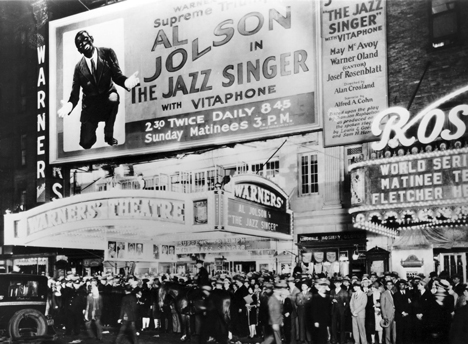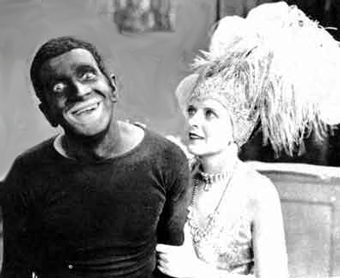
 |
|
|
|
"Toot toot, Tootsie, goodbye! Toot toot, Tootsie, don't cry!" Holding to its commitment to the history of the Warner Bros. studio, Warner Home Video gives an archival-quality restoration to what became known as the first talking picture. The Jazz Singer has been showing up on clip and compilation reels for going on seventy-six years now, almost always with a snatch of Al Jolson performing or saying the immortal words, "You ain't seen nothing yet!" For 1927 viewers amazed at the sight of a talking motion picture, those words have served as the leadoff for the entire talkie revolution. Warners' The Jazz Singer Blu-ray packages the milestone film with two additional DVDs that include a new docu as well as dozens of original Vitaphone short subjects, all restored. But the Al Jolson feature remains the draw -- respectably restored in HD, it's less a fossil from the dawn of sound than a fully realized star-vehicle musical that uses its talkie sequences to wow the audience. 
The story is a sentimental mix of family drama and show biz mythmaking. Cantor Rabinowitz (Warner Oland) insists that his son Jackie (at 13, Robert Gordon) follow in the family tradition. But Jackie's soul is in jazz singing. Despite the attempts of Jackie's mother Sara (Eugenie Besserer) to reconcile father and son, Jackie leaves home and spends the next ten years establishing himself as Jack Robin, an in-demand vaudeville singer. Helped by his friend Mary Dale (May McAvoy), a new stage star, Jackie wins a coveted Broadway booking and attempts a reunion with his family. His father rejects him again and falls sick. Family friend Moisha Yudelson (Otto Lederer) thinks that pop might recover if Jackie sings at an important temple service. But the service coincides with the opening night of Jackie's crucial Broadway debut! Samson Raphaelson's basic story in The Jazz Singer is pure immigrant corn that would appeal to any group in the ethnic melting pot; American cities in the early 20th century were teeming with new citizens abandoning at least some of their Old World traditions. Cantor Rabinowitz waxes apoplectic when his Jackie wants to perform in bars instead of sing holy songs. The story avoids taking sides but identifies most strongly with 'Jack Robin', the newly minted American eager to take advantage of the freedom to seek fame and fortune. The movie gets in a timeless joke when a Jewish gossip exclaims (in a title card) that Jackie might have fallen for a "shiksa", when Jackie's defection has gotten much farther than that. With his Americanized, de-ethnicized new name, Jackie is abandoning his father's traditions. Careful to not offend the Jewish audience, the movie keeps Jack Robin's possible romance with Mary Dale way in the background. Mary leads Jack to Broadway but it doesn't look like she'll land him as a husband or a lover; when she attends the temple services, she knows this world and her own just don't mix. Jack's a good boy who loves his mother, and a devout (if no longer orthodox) member of his faith. We can imagine Hollywood moguls showing this picture to their elderly, still-doubtful parents and saying, "See Mom, I'm in show biz too, but it's okay!" 
The Jazz Singer is shrewdly constructed. The only real conflict is between keeping the Holy Days and the stage dictum, "the show must go on." Jackie is unfairly squeezed into an impossible position by both sides, and the film's compromise is silly but effective. What works is the movie's unerring smarts in knowing how to use its musical numbers. Al Jolson was such a big star that it's likely that many patrons paid little attention to the plot, and instead sat wondering at his celebrity. When Jolson sings at the emotional climaxes, and finishes the film with a direct performance to the audience, the effect must have been revolutionary. The screen had 'made noise' before, but The Jazz Singer allowed Jolson to communicate right to the viewer, as in a live theater. The only other movie star that I can think of that made a career of this particular kind of performance film is Barbra Streisand. "All Talking, All Singing" shows would follow almost immediately, but we're told that The Jazz Singer has only a couple of minutes of actual synchronized dialogue. The producers seem to have been unsure about the impact of dialogue scenes, and it's weird to watch the film switch from antique inter-titles -- "New York! Broadway! HOME!" -- to the little bit of audio improvisation as Jackie serenades his mother at the piano. A minute or so later, the film switches back to the inter-titles again ("I have no son!"). The dialogue bits are good, but the film's several synch musical numbers must have been what thrilled the crowds. Warners' DVD audio engineers have of course synchronized all of these sections perfectly. We wonder what the success rate was in old theater presentations. How many times during each show did a Vitaphone projectionist have to correctly cue the double system sound-on-disc apparatus, to make the audio stay in synchronization? Look close and you may catch William Demarest in a backstage scene. A young Myrna Loy is much easier to spot -- she's even given inter-title 'dialogue.' Warners' Blu-ray of The Jazz Singer is an appreciable improvement over the earlier (2007) three-disc DVD release. The audio is quite clear, sounding better than many early talkies ... it's a sure bet that the audio engineers went back to original discs to piece together the soundtrack, as there's little or no hiss. Original overture and exit music cues help us imagine the added 'road show' appeal of the film's initial engagements. 
The new package is also a three-disc set, containing the same mountain of extras. A lot of loose printed items in the DVD set have been incorporated into an 88-page souvenir book -- vintage photos, reproductions of original souvenir programs, and Vitaphone promotional booklets. All that's really missed from the earlier set is the pamphlet guide to the extra contents on the set's Disc 2 and 3. Accompanying the feature on the Blu-ray disc 1 are a commentary with Vitaphone expert Ron Hutchinson and Vince Giordano, the Nighthawks bandleader. Other Al Jolson shorts include an introductory musical piece (with Jolson again in blackface) and several appearances in horse racing themed one-reelers. In addition to a 1947 radio show version also starring Jolson, Fred "Tex" Avery's cartoon I Love to Singa turns out to be a full-on Jazz Singer parody. Discs 2 and 3 are the same DVDs that held extras in the 2007 set. Disc two has a new documentary The Dawn of Sound: How Movies Learned to Talk, which simplifies the story of the competition to invent a winning talking movie system down to Vitaphone and sound-on-film approaches pioneered by DeForest and Case. Their internal discord resulted in Vitaphone getting out the gate first, although Case's Movietone system would become the standard only a couple of years later. Five more short subject docus on sound film are also included. Several are self-congratulatory pieces produced by Warners, and one is an animated cartoon. We also get a couple of sound excerpts from the 1929 Gold Diggers of Broadway, which shows how much the technology improved in just a few months. Disc 3 carries a tall list of Vitaphone shorts, all presumably filmed in New York and benefiting from easy access to New York show talent. As explained in the larger docu, these short subjects record the Vaudeville entertainers of the day, in a medium that would soon make live traveling performers redundant. Over twenty shorts are included, with everything from barbershop quartets to all-girl orchestras. Some motivate the music with little storylines, as when a group of police singers rehearse in the precinct before performing at an orphanage. Others just plunk the performers in front of a curtain. We see comedy teams that are still amusing and some whose popularity must be taken on faith; one lady performer arranges an entire act around the gag of hiding her indiscretions from her children by spelling out words instead of saying them. That wouldn't work in a silent movie. The standouts are sublime. Baby Rose Marie (Rose Marie from The Dick Van Dyke Show) is a five year-old knockout. George Burns and Gracie Allen are too cute to be believed. The disc set comes in a sturdy black book-style folder.
On a scale of Excellent, Good, Fair, and Poor,
The Jazz Singer Blu-ray rates:
Reviews on the Savant main site have additional credits information and are often updated and annotated with reader input and graphics. Also, don't forget the 2011 Savant Wish List. T'was Ever Thus.
Review Staff | About DVD Talk | Newsletter Subscribe | Join DVD Talk Forum |
| ||||||||||||||||||